As an Amazon Associate I earn from qualifying purchases.
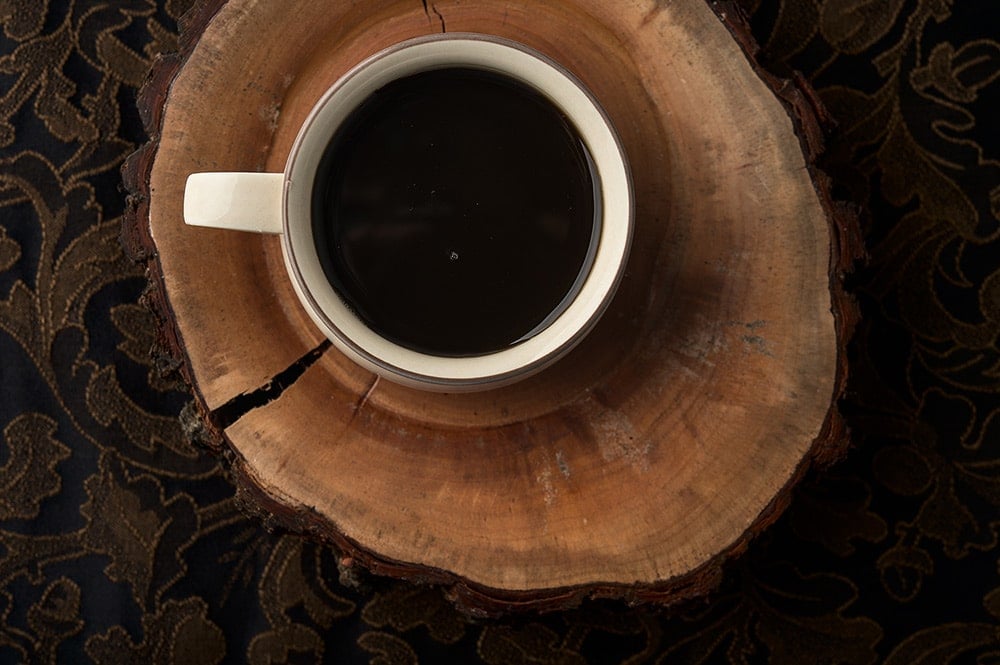
I get weird looks every time I mention mesquite bean syrup. But then, that’s because I don’t live in the Southwest.
Up here in NorCal, everyone thinks I am somehow magically making a syrup from the wood they use for grilling, and so I get a lot of squinched-up noses at that idea. (It’s not as insane as you might think: Hickory syrup is made with the bark of that tree.) No, I am making syrup out of mesquite’s dried bean pods. Yes, mesquite is both a tree and a legume, so it puts out beans. Kinda like a honey locust tree, or a redbud.
Mesquite can be found in Southern California, southern Nevada, Arizona, New Mexico, the southeast corner of Colorado, most of Texas, and in little scattered pockets of Oklahoma, Kansas, and Missouri. It’s also a non-native invasive in Australia, so if you Aussies are reading this, here’s something you can do with this plant.
You can easily buy mesquite flour in places like Whole Foods, and it’s made from beans of a South American variety of mesquite, so I am sure you can make syrup from that flour. But I’ve never done it. If you have, let me know how it went in the comments, OK?
All told, there are about a dozen species, the best of which are honey mesquite (Prosopis glandulosa), velvet mesquite (P. velvtina), and the screwbean mesquite, which is P. pubescens. I am using honey mesquite for this recipe, but any variety works.
Simply gather your beans and make sure they are very dry, which normally isn’t hard in the desert. Only thing you’ll notice are little holes in the beans.
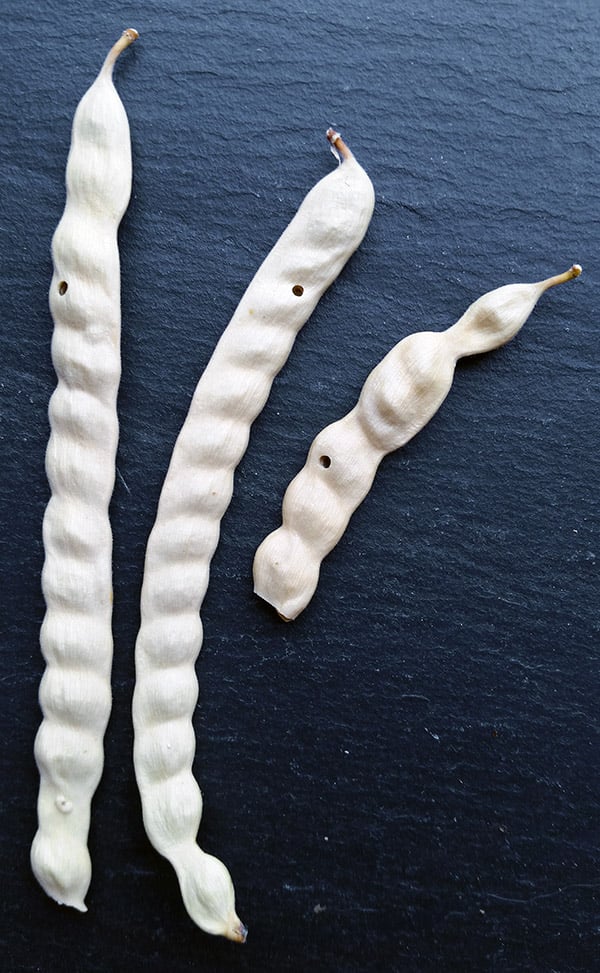
These are caused by bruchid beetles, whose larvae bore their way out of the dry pod. So yeah, they are exit holes, not entry, which means you are not likely to eat a ton of little larvae. Even if there are some in your beans, who cares? They’re teeny and will be cooked to death with the bean pods as you make the syrup. So don’t sweat it.
So how to make mesquite bean syrup?
It’s actually very simple because the bean pods are naturally sugary; there is no sugar added. In a nutshell, you break up the pods, steep them in water, and that water becomes your syrup.
Here’s how. First, I use a ratio of 1 gallon of water to 1 pound of beans. Smash them up as best you can. I put the beans in a heavy duty plastic Ziploc and bash them with a rubber mallet. You’ll never destroy the seeds, but that’s fine.
You don’t want to boil or even simmer the water. This is very important. Beer brewers will know why: Higher temperatures extract tannins and other bitter compounds from the pods, which can wreck your syrup. Slow and low is the key.
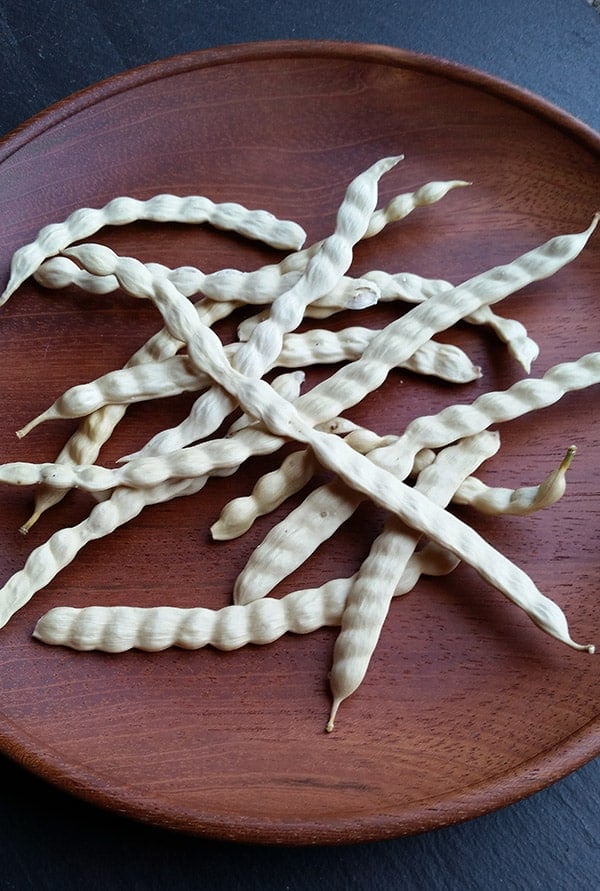
You can do this in a low oven, or on the stovetop set on low, but the best method is in a slow cooker. Just put all your crushed beans and water in the slow cooker, set it so it will never even simmer, put the lid on and walk away.
How long? At least overnight, and 20 to 24 hours is better. Strain the liquid through a fine-mesh strainer first, then again through a paper towel or cheesecloth to get the fine, suspended particles out.
You now have an awesome liquid the color of dark chocolate, with a high enough sugar content to brew into alcohol if you wanted to: 1 gallon of water with 1 pound of crushed mesquite pods steeped 18 hours got me a specific gravity reading of 1.030, which would make a beer of about 3% alcohol.
That’s not strong enough to be a syrup, though. Now you need to reduce the liquid to get it to the sweetness you want.
Again, don’t boil it. I pour the syrup into a pot and heat it to the steaming point, and let that cook very gently until it is reduced by half, about 2 hours. Slowly reducing the syrup produces cleaner flavors than you’d get by boiling it down.
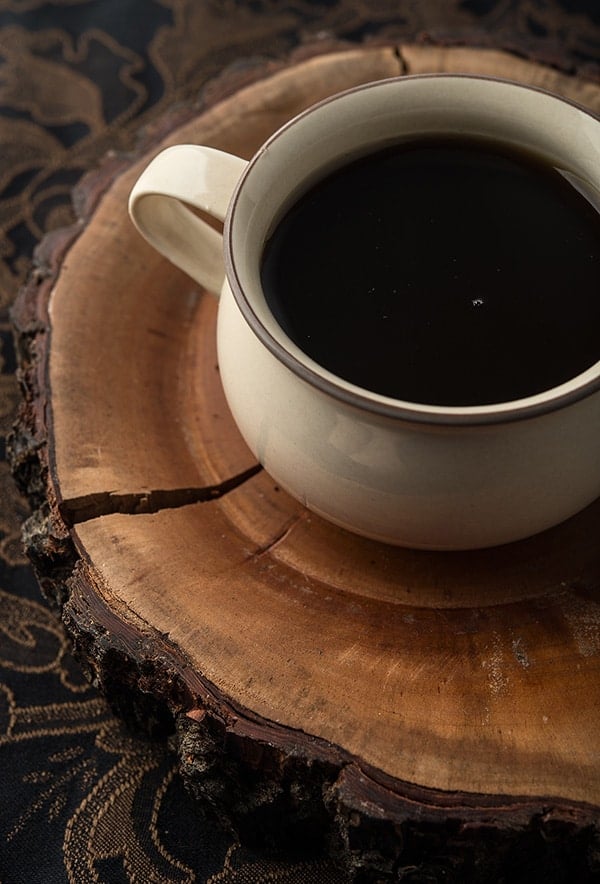
And what are those flavors? They are borderline mystical. Seriously.
Mesquite bean syrup combines hints of malt, mocha, cinnamon and vanilla with a definite woody background. It is wonderful stuff you need to taste to fully appreciate.
And, since mesquite is common-to-invasive wherever it lives, you might as well make use of it, right?

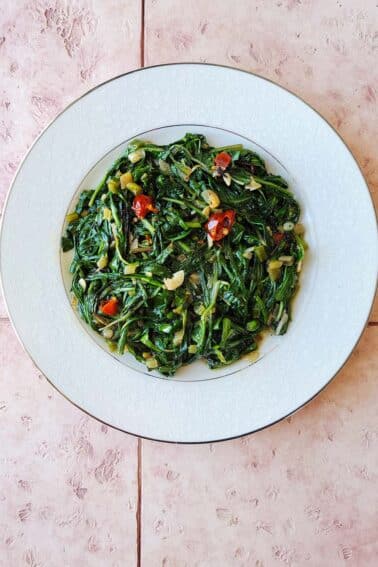
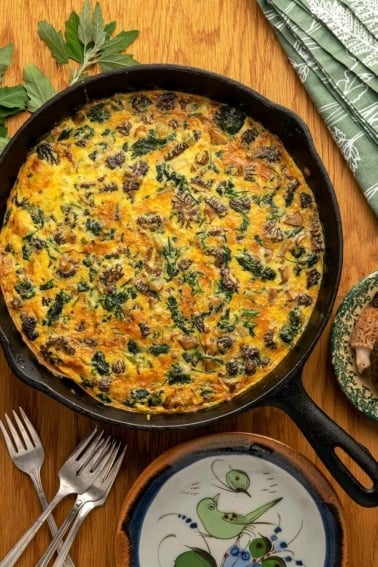
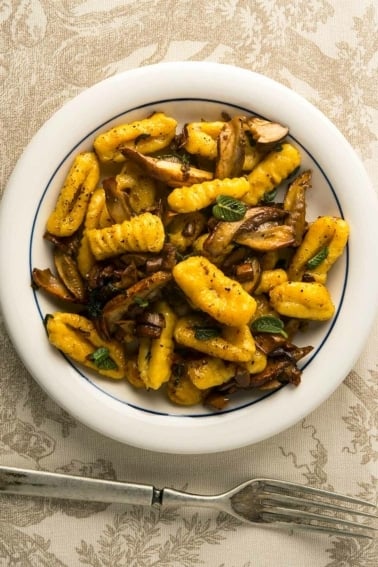
I have a native tree from Arizona. I am pretty sure it is the velvet mesquite. I tried making syrup with it, but it is extremely liquidy. I am not sure what went wrong. I set my Instant Pot on low 185° for 20 hours. It was not syrupy at all.
I haven’t event tasted for flavor, I am more concerned about the consistency of it.
Any thoughts on why it did not thickened?
Thanks!
Ali: It won’t really thicken. You need to cook it down after this initial process to concentrate the sugars enough for it to be a syrup. Remove all the solids, strain it, and then set it on the stove to cook down by half, very slowly, if you want a thicker syrup.
Hank,
Thank you for the quick response. I will try that.
If it doesn’t work, maybe it’ll still be good for my compost pile.
Hola Hank,
I was looking for a recipe for green mesquite beans (not pintos from the Green Mesquite restaurant in Austin) when I found this. Amazing. One I’ll be trying this year.
My little place on the Central Texas prairie is covered with mesquite. I don’t know what variety but I’m looking for ways to use it other than wood.
Have you cooked green mesquite pods? Or prickly lettuce? If I sent you pictures of a mushroom growing here that looks like a Strophia, would you be willing to look at it and possibly identify it? This year, along with peppergrass has been bountiful.
Thanks for whatever you’re willing to share.
— jay
Jay: I’ve not worked with green mesquite pods, no. Sorry. I have eaten very young prickly lettuce, but once it get hot, it’s too bitter to eat.
Be aware that mesquite beans can carry aflatoxins. Follow the guidance here at Desert Harvesters about how to avoid: https://desertharvesters.org/resources/Documents/AFLATOXINS-AND-HOW-TO-AVOID-THEM-FINAL.pdf
Interestingly, peanuts also can carry aflatoxins. Seems like that industry has figured out a way to avoid them pretty well.
I made mesquite flour before reading this recipe. I want to make the syrup using the flour but saw a few comments about it turning into paste. If more water was added, I wonder if you could still use the flour to make syrup. Anybody else have luck with making syrup from the flour? Please tell me how you did it. Thanks!
I live in South Texas where mesquite covers the land. I notice certain wild animals eat the pods but, seemingly, only the dry, brown pods that have likely already fallen from the tree. Judging by what I find on the ground, it looks like animals chew them thoroughly and then spit them out. The green ones, when opened, contain ‘beans’ that taste like uncooked, green beans. They aren’t sweet but taste OK and I wonder why animals don’t eat them? I’ve tried chewing the pods of dried up mesquite that have fallen to the ground. Moderately sweet. I haven’t tried to extract it but got some mesquite candy from a Lippan Apache woman. Wonderful.
I therefore suspect that the pod contains the sugar, not the seeds. Am I right? Is mesquite flour ground up pods, seeds or both?
I
I live in Tucson and mesquite pods are ground for flour as the native people have done who lived here 100 years ago and longer. This is a more recent revival of harvesting and grinding mesquite pods. Mesquite tortillas are sweet and delicious and rare to find here but worth the cost. I like to consider to take some mesquite pods and leave many for the wild creatures.
Yup, the pods have the sugar, not the seeds inside. Seeds have more protein and oil.
Hi. We have many mesquite trees on our farm. The trees used to be planted for sheep fodder but is now a declared invasive species. We are located in the Northern Cape Province, South Africa. I have tried making syrup from the pods with mixed results. I will keep on trying untill I get something that is fit for the South African palate. We saffas like bold intence flavours. I think the pods have potential.
Some additional advice would be great.
Kind regards
Eric Pieters
May I use your recipe for syrup in a children’s book I am writing? I will give you credit for it. In Central Texas, I gather mesquite beans at the same time I get prickly pears. I have never made syrup, but have made jelly and gruel. I also have a recipe for a mesquite bean lemonade. My book will have recipes for every “moon” of the month. In my family, the full moon in August is called the Prickly Pear Moon.
Hi linda. I’m extremely interested in learning about your mesquite bean lemonade. Would you be willing to share with me? Thank you in advanced.
I recently moved to Arizona and we have at least 3 varieties of mesquite. We are exploring ways to enjoy them. I would love to try your lemonade recipe.
Worth every ounce of the effort, you are an inspiration, as I continue to teach the younger generation!
Your description of the flavor of the mesquite syrup reminded me of the flavors in the vodka infusion liqueur I make from carob pods. I’ll bet mesquite would make a similarly delicious product. I just break the carob pods up a bit and soak it in vodka for a couple of weeks and then add a sugar syrup to taste.
OMG, I am so doing this!!
My parents grew up in the high Sierra Madre in Mexico and chewing Mesquite beans was a sort of “candy” treat for them, so this recipe brings back memories. I have a Chilean Mesquite in my back yard and will try this next time it fruits.
I operate a mesquite flour business out of Tucson, Arizona (La Madera Mesquite, LLC) and Hank forgot to mention one thing — you have to taste the pods first. Every tree will produce pods with a different flavor — some are bitter, some sour, some tasteless, some sweet, maple, or a combination. When the pod is dry break off a small piece and chew it up carefully to get the flavor. If it tastes good it will make good syrup. If it tastes bad it will make bad tasting syrup.
Hank got lucky — he has a good tasting tree. I literally have to taste every tree I gather from to make sure the pods have the right flavor. Luckily, once you find a good tasting tree it will always be a good tasting tree, and conversely a bad tasting tree will always taste bad. If you would like more information you can contact me at lamaderamesquite@cox.net and I have flour made from Tucson, AZ pods for sale.
Absolutely. I made bitter syrup because I collected from the wrong tree. Also, avoid unripe pods because they are more tannic.
I grew up in Ohio and apples were similar. I could make delicious apple jelly from lots of apples (even tiny crab apples), but one particular apple tree tasted like straw. Those apples weren’t good out of hand or cooked. Maybe I could have made vinegar from them but I doubt it. Those were starvation apples.
Every crock pot I’ve ever seen is too hot and boils no matter if it’s in the lowest setting. Maybe an instant pot on warm…for like 2 days?
I just tried it in a slow cooker and the liquid that came out tastes very bitter with a woody flavor. I think I messed up, im gonna try to heat it slowly till I get a syrup like consistency. Any ideas on what I can do with it either way if it tastes too bitter?
Martin: Toss it. You can’t fix bitter.
The gelatin worked but I used the whole ounce container and it only took out some of the astrigentness. I am not sure if I should try to make the jelly or ditch the batch…
In mesquite, Nevada 🙂 Some of the beans where not fully ripe and I also accidently simmered the beans before I realized the heat was too high (about two hours before I realized). I order some gelatin finning, which removes tannins in home made alcohol.
My syrup came out high in tannins. Got any tricks to remove them? Gelatin finings maybe?
Tejbir: Bummer. Never had that happen. I am thinking that maybe you did not use beans from the honey or screwbean mesquite? Where do you live?
I have no idea what I am doing wrong but I am on my third batch and so far all have been inedible.
First batch was unroasted, steeped for 20 hours on low in a slow cooker and was mildly bitter. Second batch was roasted then steeped for 20 hours on low and was terribly bitter. Third batch was roasted then steeped for 3 hours on low on the stove top and was moderately bitter but not sweet at all.
All the beans were collected from one tree. Could I have collected a bad batch? They smelled great in the vehicle (like an oatmeal raisin cookie) but the results thus far have been terribly disappointing.
Thomas: Bummer. I wonder if it’s the type of tree? There are several varieties of mesquite out there, and not all make good syrup.
This So Interesting Am In An Area Full Of It Let Me Give It A Try
Is it possible to can the syrup for storing it?
Rosetta: I have kept it in the fridge for months and months. I have not yet canned it.